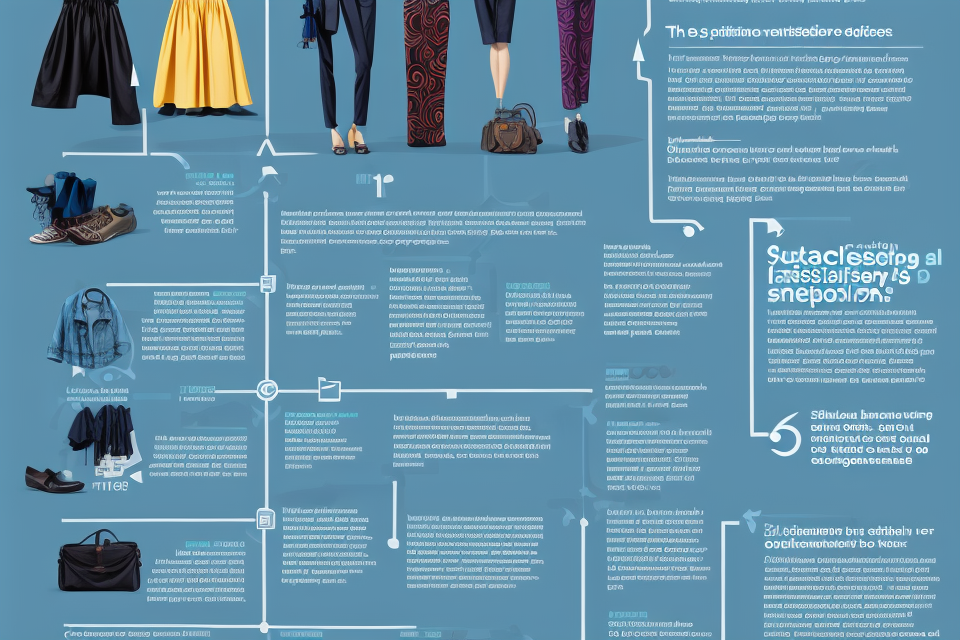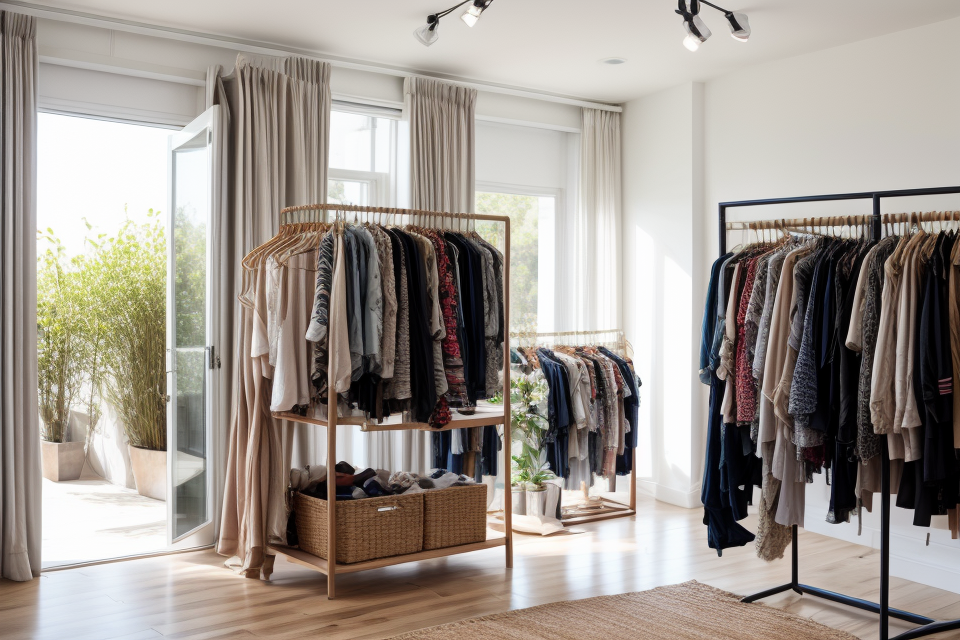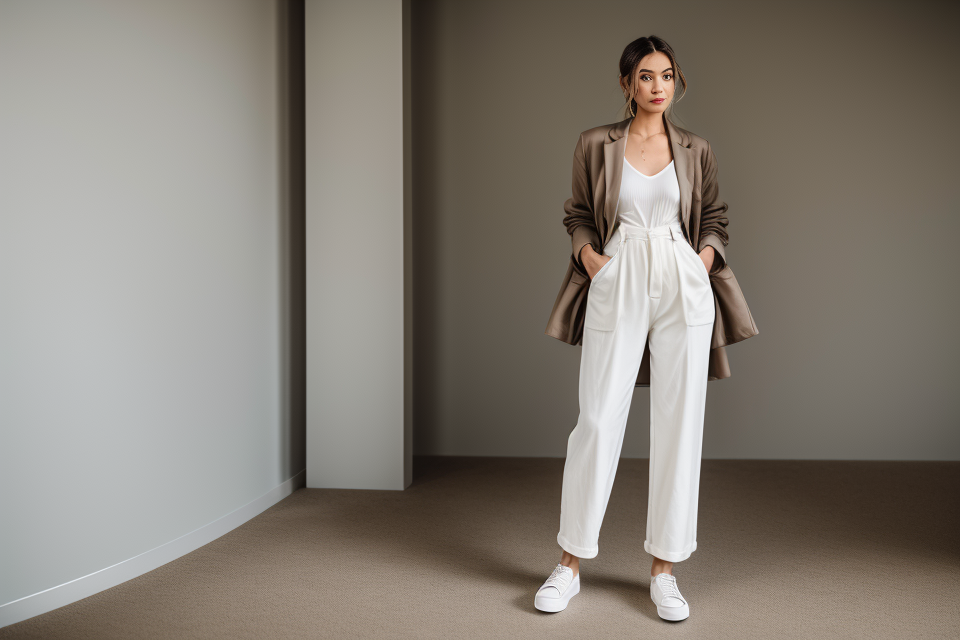
Fashion is a dynamic industry that is constantly evolving. However, with the increasing awareness of environmental concerns, the focus has shifted towards sustainable fashion. But what exactly is sustainable fashion? And which type of fashion is the most sustainable? In this article, we will explore the sustainability of different types of fashion, including organic, recycled, and upcycled fashion, and determine which one reigns supreme in terms of sustainability. We will delve into the processes involved in each type of fashion, their benefits, and drawbacks, and ultimately, answer the question – what is the most sustainable type of fashion? So, let’s dive in and explore the world of sustainable fashion!
When it comes to sustainability in fashion, there is no one-size-fits-all answer. Different types of fashion, such as fast fashion, slow fashion, and circular fashion, each have their own strengths and weaknesses when it comes to sustainability. Fast fashion is known for its low prices and trendy styles, but it is also criticized for its environmental impact and exploitation of workers. Slow fashion, on the other hand, prioritizes quality and durability over quantity and trendiness, but it can be more expensive and less accessible to some consumers. Circular fashion aims to reduce waste by reusing and recycling materials, but it can be difficult to implement on a large scale. Ultimately, the most sustainable type of fashion will depend on a variety of factors, including personal values, budget, and lifestyle.
Understanding Sustainable Fashion
Defining Sustainable Fashion
The concept of sustainable fashion
Sustainable fashion is a term used to describe a style of clothing that is produced in a way that minimizes its negative impact on the environment. This can include using eco-friendly materials, reducing water and energy consumption, and ensuring fair labor practices. The goal of sustainable fashion is to create a system that is both economically viable and environmentally responsible.
Key principles and practices
Some key principles and practices of sustainable fashion include:
- Using natural and organic materials, such as cotton, linen, and hemp, that are grown without harmful pesticides and chemicals.
- Minimizing waste by designing clothing that is durable and can be easily repaired or upcycled.
- Reducing the use of water and energy in the production process, such as by using solar power or recycling water.
- Ensuring fair labor practices, such as paying a living wage and providing safe working conditions.
- Encouraging transparency and accountability in the supply chain, such as by disclosing the names and locations of suppliers and factories.
Overall, the goal of sustainable fashion is to create a system that is both economically viable and environmentally responsible. By following these principles and practices, designers and manufacturers can create clothing that is not only stylish and affordable, but also sustainable and ethical.
The Importance of Sustainable Fashion
Sustainable fashion has gained significant attention in recent years due to the environmental and social concerns associated with conventional fashion practices. The following points highlight the importance of sustainable fashion:
- Environmental impact of conventional fashion: Conventional fashion practices involve the use of non-sustainable materials, such as synthetic fibers and petrochemical-based fabrics, which contribute to the depletion of natural resources and the generation of a substantial amount of waste. Additionally, the manufacturing process of conventional clothing often results in the emission of harmful chemicals and greenhouse gases, which contribute to climate change.
- Social and economic benefits of sustainable fashion: Sustainable fashion practices prioritize the use of eco-friendly materials, such as organic cotton, recycled polyester, and hemp, which have a lower environmental impact. By adopting sustainable practices, the fashion industry can reduce its carbon footprint and promote a circular economy, where waste is minimized, and resources are used efficiently. Furthermore, sustainable fashion can contribute to the economic development of local communities, particularly in developing countries, by creating employment opportunities and supporting fair labor practices.
In conclusion, the importance of sustainable fashion cannot be overstated. By adopting sustainable practices, the fashion industry can reduce its environmental impact, promote economic development, and contribute to a more sustainable future.
Comparing Sustainable Fashion Types
Denim and Indigo
Overview of Denim and Indigo Fashion
Denim and indigo fashion have been popular for decades, with denim jeans becoming a staple in many wardrobes. The versatility and durability of denim make it a favorite among consumers, but the environmental impact of producing denim has raised concerns about its sustainability.
Sustainable Denim Production Methods
To address these concerns, many denim brands have adopted sustainable production methods. One popular method is using organic cotton, which reduces the use of pesticides and chemicals in the production process. Additionally, some brands use recycled cotton, which reduces water usage and waste.
Another sustainable method is using laser cutting and digital printing, which reduces water and energy consumption compared to traditional methods. Furthermore, some brands have implemented zero-waste practices, where scraps of denim are repurposed to minimize waste.
Natural Indigo Dyeing Techniques
Indigo dye is a popular color used in denim fashion, but the process of producing it can be harmful to the environment. However, some brands have turned to natural indigo dyeing techniques, which use plant-based materials instead of synthetic chemicals.
One such technique is using fermented indigo, which involves soaking the fabric in a vat of fermented indigo leaves. This method produces a range of shades and is considered more sustainable than traditional synthetic indigo dyeing.
Another technique is using indigo paste, which is made from powdered indigo leaves mixed with water and soda ash. This method is also considered more sustainable as it reduces the use of synthetic chemicals.
In conclusion, denim and indigo fashion can be made more sustainable through the use of organic cotton, recycled cotton, sustainable production methods, and natural indigo dyeing techniques. By adopting these methods, denim and indigo fashion can become more environmentally friendly and continue to be a popular choice among consumers.
Upcycling and Repurposing
Upcycling and repurposing are two sustainable fashion practices that involve giving new life to old clothing items. Upcycling is the process of transforming existing garments into something new and more valuable, while repurposing involves taking old clothes and transforming them into something different but still wearable.
Both upcycling and repurposing have numerous environmental benefits. By reusing old clothes, these practices reduce the amount of waste sent to landfills and decrease the need for new raw materials. Additionally, upcycling and repurposing require less energy and resources than producing new clothes, making them more sustainable options.
Creativity is also a key aspect of upcycling and repurposing. These practices allow individuals to express their creativity and create unique pieces that reflect their personal style. Additionally, upcycling and repurposing can help individuals develop new skills and learn how to work with different fabrics and materials.
Tips for upcycling and repurposing clothes include starting with simple alterations such as hemming or adding buttons, and gradually working up to more complex projects like creating a dress from a shirt. Additionally, it’s important to consider the fabric and construction of the garment before beginning any project, as some materials may not be suitable for certain techniques.
Overall, upcycling and repurposing are two sustainable fashion practices that offer both environmental and creative benefits. By reusing old clothes, these practices can help reduce waste and promote sustainability in the fashion industry.
Second-Hand and Vintage Clothing
The fashion industry is one of the most polluting industries in the world, and sustainable fashion is a growing trend that aims to reduce its negative impact on the environment. One way to practice sustainable fashion is by buying second-hand and vintage clothing. This section will explore the resale market and its impact on sustainability, the benefits of buying second-hand and vintage clothing, and tips for shopping second-hand and vintage.
The Resale Market and Its Impact on Sustainability
The resale market is a significant aspect of the circular economy, which aims to minimize waste and maximize the value of resources. In the fashion industry, the resale market is a way to extend the life cycle of clothing and accessories, reducing the need for new production and consumption.
The resale market has experienced tremendous growth in recent years, driven by changing consumer attitudes towards sustainability and the rise of online platforms that make it easier to buy and sell second-hand clothing. The market is expected to continue to grow, with a projected value of $77 billion by 2025.
The resale market not only helps to reduce waste and conserve resources but also encourages a more sustainable consumption pattern. Instead of buying new clothes every season, consumers can extend the life cycle of their existing clothes by selling or donating them when they no longer need them.
Benefits of Buying Second-Hand and Vintage Clothing
Buying second-hand and vintage clothing has several benefits for both the environment and the consumer.
First, it reduces the demand for new clothing production, which reduces the environmental impact of the fashion industry. According to the Environmental Protection Agency, the production of new clothing generates over 15 million tons of carbon dioxide equivalent emissions annually, which is more than international flights and maritime shipping combined.
Second, buying second-hand and vintage clothing is often more affordable than buying new clothes, making it accessible to a wider range of consumers.
Third, it allows consumers to discover unique and one-of-a-kind clothing items that are not available in stores.
Fourth, buying second-hand and vintage clothing can be a way to express one’s personal style and creativity.
Tips for Shopping Second-Hand and Vintage
Shopping second-hand and vintage clothing can be a fun and rewarding experience, but it requires some knowledge and preparation. Here are some tips for shopping second-hand and vintage:
- Know your measurements: Clothing sizes can vary between brands and even between different styles within the same brand. Knowing your measurements can help you to buy clothes that fit you well.
- Inspect the item: Check the item for stains, tears, and other defects before purchasing. Make sure the item is in good condition and suitable for your needs.
- Ask questions: If you are unsure about the condition of an item, ask the seller for more information.
- Try it on: Make sure the item fits you well before purchasing. If you are buying vintage clothing, keep in mind that some styles may not be as comfortable or practical as modern clothing.
- Shop at reputable stores: When shopping online, make sure to choose reputable stores that have a good reputation for quality and customer service.
By following these tips, you can enjoy the benefits of buying second-hand and vintage clothing while minimizing your environmental impact.
Slow Fashion
The Concept of Slow Fashion
Slow fashion is a movement that encourages consumers to be more mindful of their purchasing decisions, opting for quality over quantity. This approach advocates for investing in a few well-made, durable pieces that can be worn for a long time, rather than buying a large number of cheap, poorly made garments that quickly fall apart and end up in landfills.
Slow Fashion vs. Fast Fashion
Fast fashion, on the other hand, is characterized by its rapid production cycles, low prices, and high turnover of styles. This model relies on exploiting labor and natural resources, often resulting in a negative impact on the environment and the well-being of workers.
Practical Tips for Adopting a Slow Fashion Lifestyle
- Research and support sustainable and ethical brands.
- Shop second-hand or vintage clothing.
- Invest in quality pieces that are made to last.
- Mend and alter clothing instead of discarding it.
- Rent or borrow clothing for special occasions.
- Consider upcycling or DIY projects to give new life to old garments.
- Learn about and support local textile recycling programs.
- Participate in clothing swaps with friends and family.
- Take care of your clothes by washing them less frequently and following care instructions.
- Educate yourself and others about the importance of sustainable fashion.
Eco-Friendly Fabrics
An Overview of Eco-Friendly Fabrics
In the world of fashion, sustainability has become a crucial concern. The fashion industry is one of the largest polluters, contributing to approximately 10% of global carbon emissions. One way to mitigate this impact is by using eco-friendly fabrics. These fabrics are made from natural, organic, or recycled materials, which have a lower environmental impact compared to conventional fabrics. In this section, we will discuss the various types of eco-friendly fabrics and their properties.
Common Sustainable Fabrics and Their Properties
- Organic Cotton: Organic cotton is grown without the use of synthetic pesticides and fertilizers. It is a natural, renewable resource that is biodegradable. Organic cotton is soft, durable, and breathable, making it a popular choice for clothing.
- Hemp: Hemp is a versatile fabric that is made from the fibers of the cannabis plant. It is strong, lightweight, and UV-resistant. Hemp is also a sustainable crop, as it requires minimal water and no pesticides to grow.
- Bamboo: Bamboo is a fast-growing grass that is renowned for its strength and versatility. Bamboo fabric is soft, breathable, and moisture-wicking. It is also biodegradable and requires less water and fertilizer to grow than traditional cotton.
- Tencel: Tencel is a sustainable fabric made from wood pulp. It is breathable, moisture-wicking, and biodegradable. Tencel is also manufactured using a closed-loop system, which minimizes water and energy consumption.
Comparison of Different Eco-Friendly Fabrics
When comparing eco-friendly fabrics, it is essential to consider their properties, sustainability, and cost.
- Organic Cotton: Organic cotton is a popular choice for its softness and durability. However, it is more expensive than conventional cotton due to the higher cost of production.
- Hemp: Hemp is a strong and versatile fabric that is sustainable to produce. It is also more affordable than other eco-friendly fabrics like organic cotton or Tencel.
- Bamboo: Bamboo is a sustainable fabric that is soft and breathable. It is also more affordable than organic cotton but can be more expensive than conventional cotton.
- Tencel: Tencel is a biodegradable fabric that is produced using a closed-loop system. It is more expensive than conventional fabrics but offers superior properties such as breathability and moisture-wicking.
In conclusion, eco-friendly fabrics are a crucial aspect of sustainable fashion. By understanding the properties and sustainability of different fabrics, designers and consumers can make informed decisions that have a positive impact on the environment.
Making Informed Choices
Assessing the Sustainability of Fashion Brands
When it comes to evaluating the sustainability of fashion brands, there are several factors to consider. These include:
- The materials used: Brands that use sustainable materials, such as organic cotton and recycled polyester, are generally more environmentally friendly.
- Energy consumption: Brands that use renewable energy sources and have efficient production processes are more sustainable.
- Water usage: Brands that use sustainable water sources and have efficient water treatment processes are more sustainable.
- Labor practices: Brands that pay fair wages, provide safe working conditions, and prioritize workers’ rights are more sustainable.
- Transparency: Brands that are transparent about their production processes and supply chains are more sustainable.
Some popular sustainable fashion brands include:
- Everlane
- Patagonia
- Eileen Fisher
- Reformation
- Amour Vert
To research brand sustainability, you can use the following tools:
- The Good On You app
- The Ecolife app
- The Sustainable Apparel Coalition’s Higg Index
- The Greenpeace Detox Campaign
By considering these factors and using these tools, you can make informed choices about the fashion brands you support and the clothes you wear.
Personalizing Your Sustainable Fashion Journey
Tailoring Sustainable Fashion to Your Lifestyle
When it comes to adopting sustainable fashion practices, there is no one-size-fits-all approach. The key to successfully incorporating sustainable fashion into your wardrobe is to tailor it to your individual lifestyle. To achieve this, consider the following factors:
- Lifestyle assessment: Begin by evaluating your current fashion habits, including how often you shop, what types of garments you typically purchase, and the materials you prefer. This assessment will help you identify areas where you can make changes to reduce your environmental impact.
- Sustainable alternatives: Based on your lifestyle assessment, explore sustainable alternatives that align with your preferences. For example, if you prefer fast fashion due to its affordability, consider brands that offer more sustainable options at similar price points.
Building a Sustainable Wardrobe
Creating a sustainable wardrobe involves making mindful purchases and utilizing the clothes you already own. Here are some tips to help you build a sustainable wardrobe:
- Quality over quantity: Invest in well-made, durable garments that will last longer and require less frequent replacement.
- Reuse and repurpose: Instead of buying new clothes, consider refashioning or upcycling old items. This not only extends the life of your garments but also helps reduce waste.
- Curate your wardrobe: Take a critical look at your existing wardrobe and cull items that no longer fit, are worn out, or no longer align with your style. Donate or sell these items to extend their lifecycle.
Continuously Improving Your Sustainable Fashion Choices
Adopting sustainable fashion practices is an ongoing process. To continuously improve your sustainable fashion choices, consider the following:
- Stay informed: Stay up-to-date with the latest sustainable fashion trends, innovations, and news. Follow sustainable fashion influencers, blogs, and podcasts to stay informed and inspired.
- Be a conscious consumer: Make an effort to research the brands you support, paying attention to their environmental and social impact. Consider the materials used, production processes, and labor practices when making purchasing decisions.
- Share your journey: Share your sustainable fashion journey with friends and family, encouraging them to make more eco-conscious choices. Together, we can create a ripple effect that drives positive change in the fashion industry.
FAQs
1. What is sustainable fashion?
Sustainable fashion refers to clothing and accessories that are produced with minimal environmental impact. This includes using eco-friendly materials, reducing waste, and ensuring fair labor practices. Sustainable fashion aims to minimize the negative effects of the fashion industry on the environment and society.
2. What are some examples of sustainable fashion materials?
Some examples of sustainable fashion materials include organic cotton, hemp, linen, tencel, and recycled materials. These materials are often chosen for their low environmental impact and ability to be grown or produced using sustainable methods.
3. What is ethical fashion?
Ethical fashion refers to clothing and accessories that are produced in a way that is fair and respectful to workers, animals, and the environment. This includes ensuring fair labor practices, using sustainable materials, and minimizing waste. Ethical fashion aims to promote social and environmental justice throughout the supply chain.
4. What is slow fashion?
Slow fashion is a movement that encourages consumers to buy fewer, higher-quality items of clothing that will last longer. This approach is based on the idea that fast fashion, which is characterized by cheap, disposable clothing, is harmful to the environment and to workers. Slow fashion emphasizes sustainability, durability, and quality over quantity.
5. What is the most sustainable type of fashion?
There is no one-size-fits-all answer to this question, as the most sustainable type of fashion will depend on a variety of factors, including the materials used, the production process, and the intended use of the garment. However, some types of fashion that are generally considered to be more sustainable than others include:
* Clothing made from organic cotton or other sustainable materials
* Clothing that is made to last and can be repaired or upcycled
* Clothing that is produced using fair labor practices
* Clothing that is produced locally or regionally, to reduce transportation emissions
* Clothing that is designed with a circular economy in mind, such as garments that can be easily recycled or composted at the end of their life.


